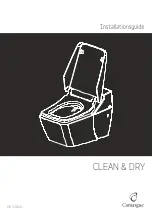
5
FI
SV
EN
DE
NO
RU
LV
LT
ET
2.2 Emptying the inner receptacle
When the inner receptacle of the toilet fills up, empty it into the
composter. If you use a biodegradable bag inside the receptacle,
place the content and the bag separately into the composter
in order to intensify the decomposing. You can place a piece of
newspaper on the bottom of the receptacle under the bulking
material.
2.3 Emptying the liquid tank
Empty the liquid tank, when necessary. In every case, empty it in
the autumn in order to prevent it from breaking due to the frost.
Urine is very rich in nutrients, especially nitrogen. It can be used
in the garden, right away diluted in water in a ratio of 1:5 or as
such, after having left it standing for three months.
2.4 Composting solid waste
For the sake of hygiene, the solid toilet waste, emptied from the
Simplett dry toilet, must be composted before utilising it in the
garden: for at least one year before applying to edible plants,
and for about half a year before applying to ornamental plants.
You can compost the toilet waste either as such or together with
garden waste and domestic waste. While composting, observe
the local regulations on waste handling, and consider sufficient
protective distances to neighbours, wells and nearby bodies of
water. Burying waste in the ground is prohibited. Composting
toilet waste always requires a solid composter with a cover. For
example, Biolan Garden Composter or Biolan Stone Composter
are suitable for the purpose.
2.5 Cleaning
All parts of the Simplett dry toilet can be cleaned using any
common domestic cleaning agent. The parts of the toilet can
be disassembled, and, if you disconnect the liquid removal and
ventilation pipes, you can even take the unit out. Wash the liquid
bowl at the top and the liquid funnel (part 8). Flush the liquid
pipe (part 7) with warm water and a mild detergent or crystal-
lised sodium at least once a year to remove any precipitate that
the urine may have formed.
3. PROBLEMS THAT MAY OCCUR
3.1 Odour
If odour problems occur, check that there is no liquid at the bot-
tom, under the inner receptacle. If there is liquid, check the con-
nections of the liquid pipes, and as required, wash the internal
parts of the unit (see point 2.5). You can also prevent the odour
problems by pouring a small amount of water into the liquid fun-
nel after each time the toilet is used. Also remember to cover the
excrements with a sufficient amount of bulking material.
3.2 Insects and maggots
If flies, for example, appear in the toilet space, empty and wash the
inner receptacle and check that the body is clean (see point 2.5).
Do away with any flying insects in the toilet space using pyre-
thrin-based spray. Consult your local dealer to select a suitable
product. Also ensure that the ventilation is adequate, and that a
sufficient amount of bulking material has been applied.
























